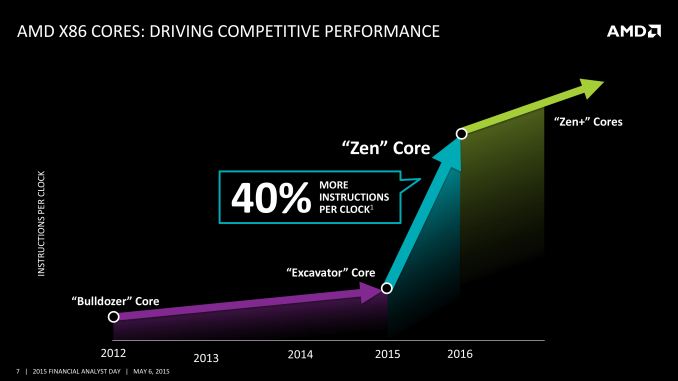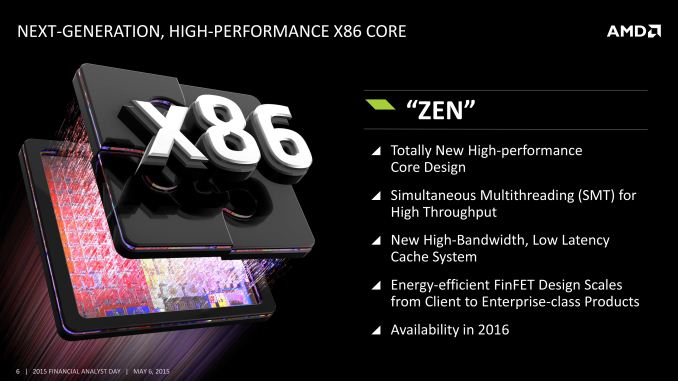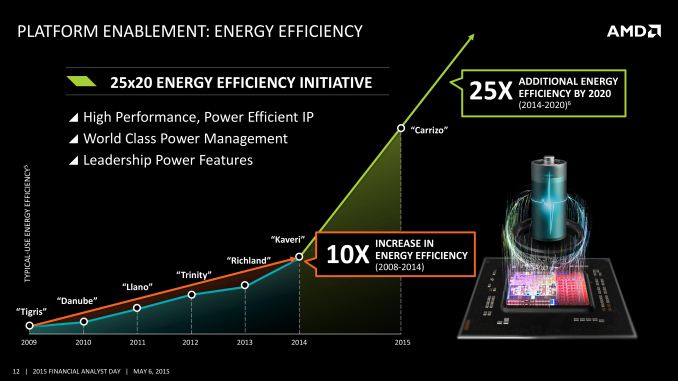AMD’s 2016-2017 x86 Roadmap: Zen Is In, Skybridge Is Out
by Ryan Smith on May 6, 2015 2:02 PM EST- Posted in
- CPUs
- AMD
- AMD FAD 2015
- Zen

AMD’s CTO Mark Papermaster just left the stage at AMD’s 2015 Financial Analyst Day, and one of the first things he covered was AMD’s CPU technology roadmap for the next couple of years.
The big question on everyone’s mind over the last year has been AMD’s forthcoming x86 Zen CPU, developed by Jim Keller’s group, and Papermaster did not disappoint, opting to address the future of AMD’s x86 plans first and foremost. AMD is not releasing the complete details on Zen until closer to its launch in 2016, but today they are providing some basic details on the CPU’s abilities and their schedule for it.
In terms of features, AMD once again confirmed that they’re aiming for significantly higher performance, on the order of a 40% increase in Instruction Per Clock (IPC) throughput. In a significant shift in threading for AMD’s x86 CPUs, Zen will also shift from Bulldozer’s Clustered Multithreading (CMT) to Simultanious Multithreading (SMT, aka Intel’s Hyperthreading). CMT is the basis for Bulldozer’s unusual combination of multiple integer cores sharing a single FPU within a module, so the move to SMT is a more “traditional” design for improving resource usage, and it means Zen will similarly have a more traditional resource layout. AMD is also labeling Zen’s cache as a “high-bandwidth, low latency cache system,” though at this time they aren’t quantifying just how that differs from the Dozer family’s cache.
Meanwhile AMD has confirmed that Zen will be shipping in 2016, and that it will be produced on a yet-to-be-named FinFET process. Our bet would be that AMD continues to use traditional partner (and spin-off fab) GlobalFoundries, who will be ramping up their 14nm equipment for next year as part of their licensing/partnership with Samsung to implement Samsung’s 14nm FinFET process. Zen at this time is AMD’s priority, to the point where the company is willing to push back the ARM K12 in order to get Zen out the door first.
Desktop users will be happy to know that the first Zen processor out the door will be AMD’s high-end desktop CPU (AMD was very deliberate in this, it’s not an APU). AMD will be aiming high and then cascading Zen down into APUs and lower-end products.
Said Zen CPU will use a new AMD platform – AM4 – which will also support DDR4. Unlike the Dozer family, all of AMD’s desktop CPUs will use the same AM4 platform/socket, so when AMD does ramp up their Zen APU, it too will be on AM4 and not its own socket, simplifying the process.
Finally, AMD’s roadmap for Zen over 2016-2017 calls for further improved Zen cores, “Zen+”, later on. Though the biggest jump for AMD comes from the transition from Dozer to Zen, the company is looking to push the envelope on IPC harder than they did with the Dozer family, projecting a higher increase in IPC over time than what we saw with the Dozer parts.
As for what this means for single-threaded performance, that remains to be seen. After having chased a lower-IPC/higher-clockspeed strategy in an attempt to do something different from Intel – the AMD that designed Bulldozer thought it wise not to try to beat well-funded Intel at their own game – the focus on higher IPC is arguably the correct move to make as the laws of physics have continued to keep 5GHz+ clockspeeds from being efficient enough to be practical. That said, single-threaded performance is a combination of IPC and clockspeed, so to be competitive with Intel AMD needs to deliver higher IPC while maintaining relatively high clockspeeds, and the latter is not something AMD is disclosing this early in the process.
Finally, we’ll note that this roadmap is empty of any mentions of project Skybridge. CEO Lisa Su has commented that AMD has decided to change their focus away from Skybridge based on customer feedback. Customers were telling AMD that they didn't necessarily need socket compatible solutions, so AMD is going to work on differentiated solutions. That said, given that Skybridge was announced last year and planned for 20nm, I suspect that it has also become a victim of the short lifespan (and underperforming nature) of 20nm, leading to it being downplayed in favor of 14nm prodcts.
Meanwhile also absent was any further mention of AMD's Cat cores. Zen would appear to be AMD’s top-to-bottom x86 core, a significant departure from an AMD who previously wanted separate designs for the 10W-100W market and sub-10W markets.














59 Comments
View All Comments
Novacius - Wednesday, May 6, 2015 - link
They don't want to get into smartphones and so on, not even with K12, and they said that directly.mczak - Wednesday, May 6, 2015 - link
Don't forget intel scales down their desktop core down to 4.5W as well (Core M), with some overlap with atoms. This is of course heavily downclocked and comes with its own challenges in terms of heat dissipation (as you can clearly see some designs do far worse wrt throttling than others using the same cpu), but seems to fit into larger tablets just fine. And AMD, unlike intel, doesn't have any aspirations to fit it into phones.So, even though I thought the cat cores were doing quite ok, that probably was because the high-end core wasn't that good... And not having to develop two completely different cpu cores of course saves development resources.
Xenonite - Thursday, May 7, 2015 - link
Sadly this "one design from 1W to 100W" philosophy, understood in the context of "... GlobalFoundries, who will be ramping up their 14nm equipment for next year as part of their licensing/partnership with Samsung to implement Samsung’s 14nm FinFET process." means that we won't be seeing any real performance improvements (for at least the next 2-3 years) on AMD's side at least.Simply put, the escalating costs of semiconductor manufacturing R&D means that investors are only willing to swallow that large initial expense if the primary focus is on developing smaller, lighter and lower-performing products for the mobile market (where all the growth is presumed to be).
Even if AMD had the financial reserves to pull off 2 completely difderent designs, Samsung's commitment to a low-leakage and high density 14nm process would immediately kill either the yields or the clock-rates that AMD could achieve with their high-performance design.
The other thing that people tend to forget while they needlessly mumble on about power comsumption and the impracticality of 100W+ CPUs is the fact that we have already been able to quietly and efficiently cool 200W+ GPUs with ambient air for many years now.
Sure, it might mean that your PC-case has to have its depth increased by an inch or two (which probably does sound like the end of the world to quite a few fashion-conscious environmental activists), but if both the manufacturing process and the CPU were designed for a 200W TDP and a layout maximizing heat dissipation (not just for maximum transistor density to lower production costs) was allowed, then a 6GHz-7Ghz dual core (perhaps even a quad core with less cache) CPU, with IPC slightly exceeding that of Intel's Broadwell architecture, would be entirely within the realm of possibility.
After also taking into account the average expected area cost per transistor for most manufacturer's next-generation "14nm" process nodes and allowing an increase of around 150% in the metal interconnect wire's thickness to help drain parasitic capacitances fast enough for reliable operation at up to 7GHz (especially important in the clock distribution tree, i.e. to minimize skew), a CPU like this would be manufacturable in less than 500mm² if the voltage regulation and some peripheral controllers were moved back off-chip. Even with NVIDIA-style profit margins, a complete GPU board containing a chip of that size would only cost about $699-$799, therefore I am confident that this lone AMD CPU could be brought to market a lot closer to $600 while being more than twice as fast as an Intel Core i7-5960x in today's games and applications.
I do apologise, this has begun to feel a bit like a pointless psychotic rant; It's just that every bit of news that might signal some actual CPU performance breakthrough (from Intel or AMD and that is NOT ARM related) has been a constant dissapointment since the launch of the Sandy-Bridge microarchitecture.
With peak clock-rates continually falling as every manufacturer scrambles to develop a less powerfull processor than before, there just really doesn't seem to be anything to look forward to.
I have been assembling my own powerfull PCs (as most PC-enthusiasts do) since childhood, replacing my primary system about once a year, and I still haven't seen any reason to replace my 5.3GHz Sandy-Bridge-based system. I don't think that the PC as an industry is in any danger of being replaced or anything dramatic like that, it just seems to have lost its passion and abandoned the quest for picture-perfect virtual reality in favour of "good enough so that most people won't notice at 20-30fps" reality. More compromises to eable thinner and lighter is not much to look forward to or be exited by if you ask me.
lilmoe - Wednesday, May 6, 2015 - link
Just when I was wondering what the heck they were doing, seems like they have a plan. Can't wait to see how things turn out. I must admit that I wasn't following too much on AMD news though.chizow - Wednesday, May 6, 2015 - link
Scrapping SkyBridge made sense, it was just logical after they shutdown/wrote off SeaMicro. No market for their micro servers. No market for AMD ARM chips, no point in bridging the platforms with SkyBridge. Just the last obvious domino to fall.I just wish AMD didn't quantify those IPC gains for Zen before they had working samples...just dangerous to set expectations like that when they don't even have their process set yet. What if it is 40% IPC increase but 50% reduction in clockspeeds, for example? People will only remember that graph with the big 40% increase spike.
In any case, if AMD makes it to 2016, Zen will be without a doubt, the make or break moment for them as a future going concern in the semiconductor industry.
dishayu - Wednesday, May 6, 2015 - link
I would like to see Zen destroy Intel in downright performance. This era of Intel's utter domination has gone far too long and I'm a little bit sick of Intel stalling any significant performance updates to their CPUs. All we get is low single-digit percent performance gains with every generation. And the only way to change that is to have AMD back in the game./rant
RussianSensation - Wednesday, May 6, 2015 - link
Not going to happen. Intel can always drop higher SKUs to lower price levels and negate any performance advantage AMD will have. If Intel needs to, they can drop a 6-core 5820K CPU to $299 and bring out an 8-core at $399. Their profit margins are so sky high, they can easily do it.Crunchy005 - Wednesday, May 6, 2015 - link
Which means they have been overcharging the whole time...Thank you for pointing out exactly what competition does.SaberKOG91 - Wednesday, May 6, 2015 - link
At the risk o sounding pedantic, Hyperthreading is Intel's current marketing term for their implementations of SMT. These terms should not be used interchangeably. SMT is any superscalar core architecture that allows instructions for multiple threads to run at the same time. And it doesn't have to only be two threads (HT) there are other SMT approaches that use 4 or even 8 way scheduling.ZeDestructor - Wednesday, May 6, 2015 - link
Technically it doesn't have to be superscalar, but it does help in making it actually useful :PAnd yeah, POWER is already there with 4T per core designs shipping and 8T per core in development. Interestingly enough though, IBM decided to go to an in-oder core design rather than the OOO design it previously implemented.. I wish I could get a POWER box to poke around with...